Related Research Articles

King George's War (1744–1748) is the name given to the military operations in North America that formed part of the War of the Austrian Succession (1740–1748). It was the third of the four French and Indian Wars. It took place primarily in the British provinces of New York, Massachusetts Bay, New Hampshire, and Nova Scotia. Its most significant action was an expedition organized by Massachusetts Governor William Shirley that besieged and ultimately captured the French fortress of Louisbourg, on Cape Breton Island in Nova Scotia, in 1745. In French, it is known as the Troisième Guerre Intercoloniale or Third Intercolonial War.
Tatamagouche is a village in Colchester County, Nova Scotia, Canada.

Canso is a community in Guysborough County, on the north-eastern tip of mainland Nova Scotia, Canada, next to Chedabucto Bay. In January 2012, it ceased to be a separate town and as of July 2012 was amalgamated into the Municipality of the District of Guysborough. The area was settled in 1604, along with the original Port-Royal. The construction of a British fort in the village in 1720 was instrumental in contributing to the outbreak of Dummer's War in 1722. The town is of national historic importance because it was one of only two British settlements in Nova Scotia prior to the establishment of Halifax (1749). Canso played a key role in the defeat of Fortress of Louisbourg. Today, the town attracts people internationally for the annual Stan Rogers Folk Festival.
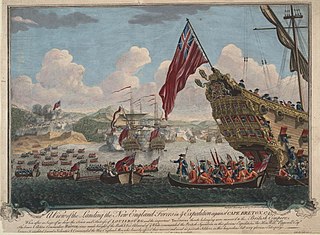
The Siege of Louisbourg took place in 1745 when a New England colonial force aided by a British fleet captured Louisbourg, the capital of the French province of Île-Royale during the War of the Austrian Succession, known as King George's War in the British colonies.

The Raid on Canso was an attack by French forces from Louisbourg on the British outpost Fort William Augustus at Canso, Nova Scotia shortly after war declarations opened King George's War. The French raid was intended to boost morale, secure Louisbourg's supply lines with the surrounding Acadian settlements, and deprive Britain of a base from which to attack Louisbourg. There were 50 English families in the settlement. While the settlement was utterly destroyed, the objective failed, since the British launched an attack on Louisbourg in 1745, using Canso as a staging area.
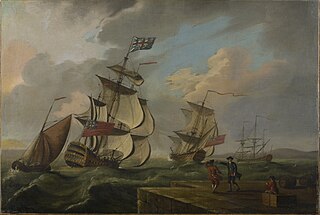
John Rous was a Royal Navy officer and privateer. He served during King George's War and the French and Indian War. Rous was also the senior naval officer on the Nova Scotia station during Father Le Loutre's War. Rous' daughter Mary married Richard Bulkeley and is buried in the Old Burying Ground in Halifax, Nova Scotia.

The siege of Annapolis Royal in 1744 involved two of four attempts by the French, along with their Acadian and native allies, to regain the capital of Nova Scotia/Acadia, Annapolis Royal, during King George's War. The siege is noted for Governor of Nova Scotia Paul Mascarene successfully defending the last British outpost in the colony and for the first arrival of New England Ranger John Gorham to Nova Scotia. The French and Mi'kmaq land forces were thwarted on both attempts on the capital because of the failure of French naval support to arrive.
John Gorham was a New England Ranger and was the first significant British military presence on the frontier of Nova Scotia and Acadia to remain in the region for a substantial period after the Conquest of Acadia (1710). He established the famous "Gorham's Rangers". He also commissioned two armed vessels: the Anson and the Warren, who patrolled off Nova Scotia.
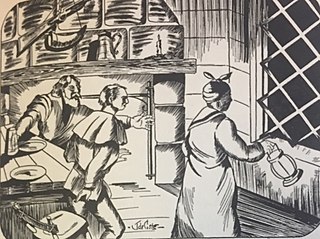
Joseph Gorham was an American colonial military officer during King George's War and later a British army commander during the Seven Years' War and the American Revolutionary War. He is best known for leading a company of British imperial Rangers, called Gorham's Rangers, during the 1750s and early 1760s. Gorham's unit played an important role in the French and Indian War and were early practitioners of American frontier warfare, more commonly known as petite guerre or Guerrilla warfare. He also became Governor of Placentia.
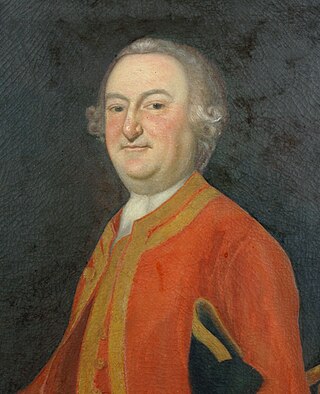
The Bay of Fundy campaign occurred during the French and Indian War when the British ordered the Expulsion of the Acadians from Acadia after the Battle of Fort Beauséjour (1755). The campaign started at Chignecto and then quickly moved to Grand-Pré, Rivière-aux-Canards, Pisiguit, Cobequid, and finally Annapolis Royal. Approximately 7,000 Acadians were deported to the New England colonies.

The Battle of Winnepang occurred during Dummer's War when New England forces attacked Mi'kmaq at present day Jeddore Harbour, Nova Scotia. The naval battle was part of a campaign ordered by Governor Richard Philipps to retrieve over 82 New England prisoners taken by the Mi'kmaq in fishing vessels off the coast of Nova Scotia. The New England force was led by Ensign John Bradstreet and fishing Captain John Elliot.
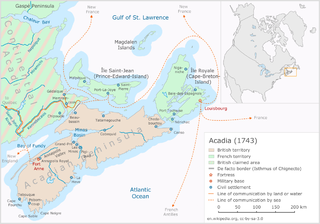
Father Le Loutre's War (1749–1755), also known as the Indian War, the Mi'kmaq War and the Anglo-Mi'kmaq War, took place between King George's War and the French and Indian War in Acadia and Nova Scotia.c On one side of the conflict, the British and New England colonists were led by British officer Charles Lawrence and New England Ranger John Gorham. On the other side, Father Jean-Louis Le Loutre led the Mi'kmaq and the Acadia militia in guerrilla warfare against settlers and British forces. At the outbreak of the war there were an estimated 2500 Mi'kmaq and 12,000 Acadians in the region.

The Raid on Dartmouth (1749) occurred during Father Le Loutre's War on September 30, 1749 when a Mi'kmaw militia from Chignecto raided Major Ezekiel Gilman's sawmill at present-day Dartmouth, Nova Scotia, killing four workers and wounding two. This raid was one of seven the Wabanaki Confederacy and Acadians would conduct against the settlement during the war.

The Battle at Port-la-Joye was a battle in King George's War that took place with British against French troops and Mi'kmaq militia on the banks of present-day Hillsborough River, Prince Edward Island in the summer of 1746. French officer Jean-Baptiste Nicolas Roch de Ramezay sent French and Mi'kmaq forces to Port-la-Joye where they surprised and defeated a force of 200 Massachusetts militia in two British naval vessels that were gathering provisions for recently captured Louisbourg.

The action of 15 June 1745 was a naval encounter between three New England vessels and a French and native relief convoy en route to relieve the Siege of Louisbourg (1745) during King George's War. The French and native convoy of four French vessels and fifty native canoes carrying 1200 fighters was led by Paul Marin de la Malgue and the New England forces were led by Captain David Donahew. The New Englanders were successful. The Governor of Ile Royal Louis Du Pont Duchambon thought that the New Englanders would have ended their siege of Louisbourg had Marin arrived. Instead, the day following the battle, Duchambon surrendered Louisbourg to New England.

The siege of Annapolis Royal in 1745 involved the third of four attempts by the French, along with their Acadian and native allies, to regain the capital of Nova Scotia/Acadia, Annapolis Royal, during King George's War. During the siege William Pote was taken prisoner and wrote one of the rare captivity narratives that exist from Nova Scotia and Acadia.
William Pote was a British surveyor and ship captain who wrote one of the few captivity narratives from Acadia/Nova Scotia when he was captured by the Wabanaki Confederacy during King George's War.
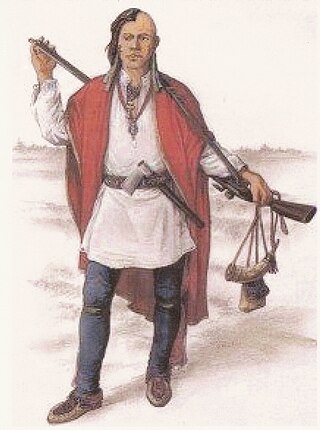
The military history of the Mi'kmaq consisted primarily of Mi'kmaq warriors (smáknisk) who participated in wars against the English independently as well as in coordination with the Acadian militia and French royal forces. The Mi'kmaq militias remained an effective force for over 75 years before the Halifax Treaties were signed (1760–1761). In the nineteenth century, the Mi'kmaq "boasted" that, in their contest with the British, the Mi'kmaq "killed more men than they lost". In 1753, Charles Morris stated that the Mi'kmaq have the advantage of "no settlement or place of abode, but wandering from place to place in unknown and, therefore, inaccessible woods, is so great that it has hitherto rendered all attempts to surprise them ineffectual". Leadership on both sides of the conflict employed standard colonial warfare, which included scalping non-combatants. After some engagements against the British during the American Revolutionary War, the militias were dormant throughout the nineteenth century, while the Mi'kmaq people used diplomatic efforts to have the local authorities honour the treaties. After confederation, Mi'kmaq warriors eventually joined Canada's war efforts in World War I and World War II. The most well-known colonial leaders of these militias were Chief (Sakamaw) Jean-Baptiste Cope and Chief Étienne Bâtard.

The military history of the Acadians consisted primarily of militias made up of Acadian settlers who participated in wars against the English in coordination with the Wabanaki Confederacy and French royal forces. A number of Acadians provided military intelligence, sanctuary, and logistical support to the various resistance movements against British rule in Acadia, while other Acadians remained neutral in the contest between the Franco–Wabanaki Confederacy forces and the British. The Acadian militias managed to maintain an effective resistance movement for more than 75 years and through six wars before their eventual demise. According to Acadian historian Maurice Basque, the story of Evangeline continues to influence historic accounts of the expulsion, emphasising Acadians who remained neutral and de-emphasising those who joined resistance movements. While Acadian militias were briefly active during the American Revolutionary War, the militias were dormant throughout the nineteenth century. After confederation, Acadians eventually joined the Canadian War efforts in World War I and World War II. The most well-known colonial leaders of these militias were Joseph Broussard and Joseph-Nicolas Gautier.

Daniel Fones was the leading military commander for Rhode Island in the Siege of Louisbourg in 1745. He was the captain of Tartar, the privateer vessel was the Rhode Island contribution to the victory at Louisbourg.
References
- ↑ Pote, William (1896). The Journal of Captain William Pote, Jr., during his Captivity in the French and Indian War from May, 1745, to August, 1747. New York: Dodd, Mead & Company. p. 174.
- ↑ History of Newburyport
- ↑ Historical Collections of the Essex Institute. Vol. III. Salem, Massachusetts: G.M. Whipple & A.A. Smith. 1861. p. 186.
- ↑ Chapin, Howard M. (1928). Privateering in King Georges̕ War, 1739-1748. E.A. Johnson Company. p. 46.
- ↑ Thomas Pichon's account
- ↑ Johnson, Micheline D. (1974). "Padanuques, Jacques". In Halpenny, Francess G (ed.). Dictionary of Canadian Biography . Vol. III (1741–1770) (online ed.). University of Toronto Press. Donahue used the same strategy of posing as a French ship to entrap Chief Pandanuques as he does in the Naval battle off Tatamagouche, after which Donahue was tortured and killed by the Mi'kmaq.
- ↑ Pierre Malliard.MEMORIAL OF THE Motives of the Savages, called Mickmakis and Maricheets, for continuing the War with England since the last Peace.
- ↑ Drake, Samuel G. (1870). A Particular History of the Five Years French and Indian War in New England and Parts Adjacent, ... Sometime Called Governor Shirley's War. Boston: Samuel G. Drake. p. 77.
- ↑ Collections of the Massachusetts Historical Society. Vol. I. Boston. 1792. p. 22.
- ↑ New England vessels in the expedition against Louisbourg, 1745 by Chapin, Howard M., 1887-1940
- ↑ Ammi R. Cutter to Pepperrell, July 7. News brought by Captain Danile Fones who was with Donahew at time of engagement. 6 Mass Historical Society Collection. X. 324.
- ↑ Louisbourg: A Focus of Conflict H E 13 By Peter Bower March 1970 Fortress of Louisbourg Louisbourg Journals, 1745 By Louis Effingham De Forest, Louis Effingham DeForest http://fortress.cbu.ca/search/HE13-8.html Archived 2012-03-13 at the Wayback Machine